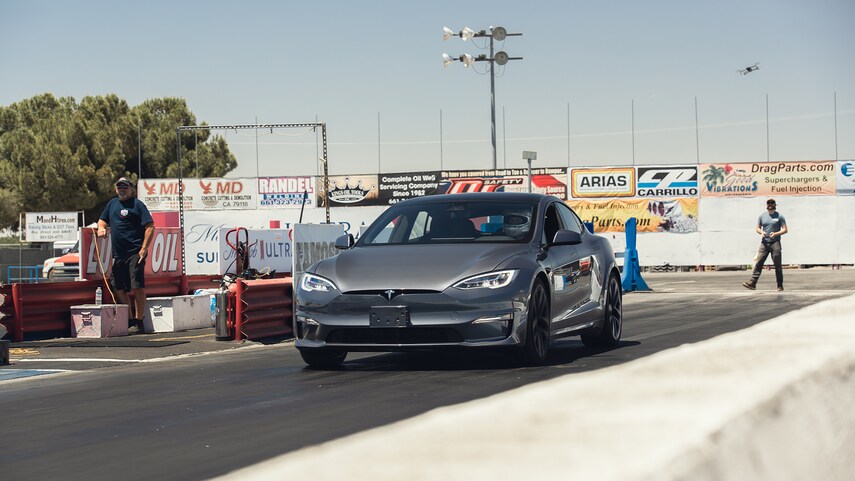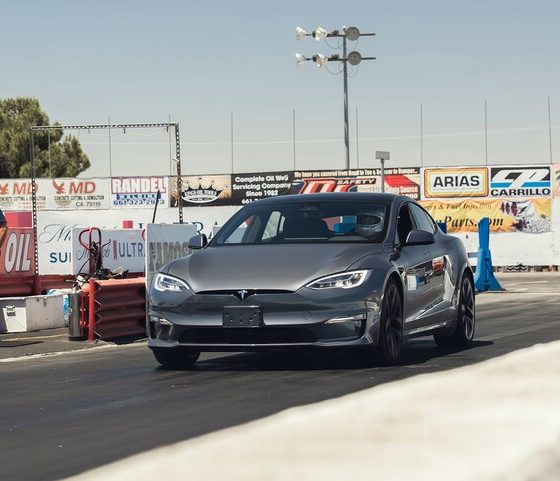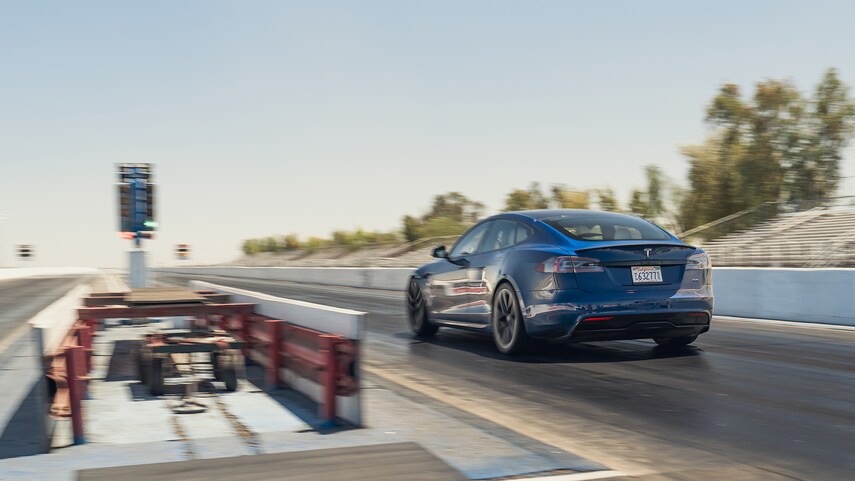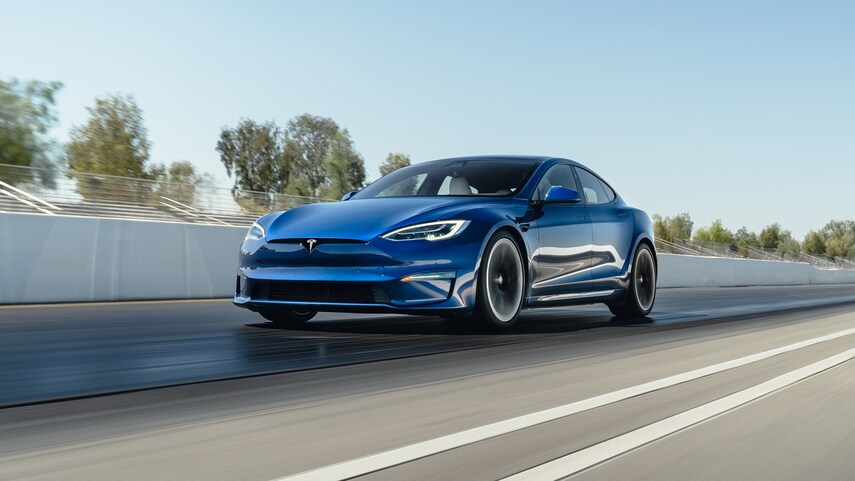

News
Tesla Model S Plaid is actually faster than its listed 1.99-second 0-60 mph time: report
The Tesla Model S Plaid’s 0-60 mph time is listed on the company’s website as 1.99 seconds, a figure that critics have challenged since it was revealed online. The idea of a four-door, family sedan that’s filled to the brim with fancy tech features is something almost alien, after all. Yet in a recent test by MotorTrend, the Model S Plaid actually proved faster than its listed 0-60 mph time, hitting highway speeds in just 1.98 seconds.
Of course, a lot had to go right for the Model S Plaid was able to accomplish this feat. As per the publication, Tesla required the Model S Plaid’s 0-60 mph launch test to be done only on a VHT-prepped surface. VHT is a formulated synthetic resin used in drag racing to increase the traction of a car’s tires. More traction means more grip, which means that vehicles could typically achieve their optimum acceleration when launching. MotorTrend noted that Tesla was adamant that the Model S Plaid be tested on a VHT-prepped surface.

After some internal discussions, the publication noted that the MotorTrend team relented to Tesla’s demands, provided that the vehicle could be tested in its Fontana test track the next day. This would allow MotorTrend to test the Model S Plaid both on the company’s terms, and on the same conditions that it’s used for other vehicles it has reviewed in the past. And with that, the Tesla Model S Plaid’s launch test was validated.
The Tesla Model S Plaid accelerated from 0-60 mph in just 1.98 seconds, faster than the company’s own figures on its official website. The quarter-mile run was achieved in 9.25 seconds at 152.6 mph, effectively making it the quickest production car that MotorTrend tested to date. Before the Model S Plaid, the fastest 0-60 mph time recorded by the publication came from the Tesla Model S P100D Ludicrous+, which hit 60 mph in 2.28 seconds. The fastest quarter-mile run was achieved by the Ferrari LaFerrari in 2015 when it completed a run in 9.74 seconds at 148.5 mph.

Both these records were shattered by the Model S Plaid. And that’s with the vehicle still not on the tires that would allow it to hit 200 mph, or the improvements that would likely be offered by a dedicated “Track Package.”
That being said, these numbers were achieved under conditions that were specifically set by Tesla. On MotorTrend’s later test in its test track without VHT, the vehicle accelerated from 0-60 mph in 2.07 seconds. That’s still over 0.2 seconds quicker than the previous record-holder, and only 0.09 seconds more than its launch in a VHT prepped surface. The publication was not able to test the Model S Plaid’s quarter-mile time in its test track, but based on its calculations, the vehicle could have finished the run in 9.34 seconds at 152.2 mph.
That’s not bad at all for a car that starts at less than $130,000.
Do you have anything to share with the Teslarati Team? We’d love to hear from you, email us at tips@teslarati.com.

News
Tesla FSD fleet is nearing 7 billion total miles, including 2.5 billion city miles
As can be seen on Tesla’s official FSD webpage, vehicles equipped with the system have now navigated over 6.99 billion miles.

Tesla’s Full Self-Driving (Supervised) fleet is closing in on almost 7 billion total miles driven, as per data posted by the company on its official FSD webpage.
These figures hint at the massive scale of data fueling Tesla’s rapid FSD improvements, which have been quite notable as of late.
FSD mileage milestones
As can be seen on Tesla’s official FSD webpage, vehicles equipped with the system have now navigated over 6.99 billion miles. Tesla owner and avid FSD tester Whole Mars Catalog also shared a screenshot indicating that from the nearly 7 billion miles traveled by the FSD fleet, more than 2.5 billion miles were driven inside cities.
City miles are particularly valuable for complex urban scenarios like unprotected turns, pedestrian interactions, and traffic lights. This is also the difference-maker for FSD, as only complex solutions, such as Waymo’s self-driving taxis, operate similarly on inner-city streets. And even then, incidents such as the San Francisco blackouts have proven challenging for sensor-rich vehicles like Waymos.
Tesla’s data edge
Tesla has a number of advantages in the autonomous vehicle sector, one of which is the size of its fleet and the number of vehicles training FSD on real-world roads. Tesla’s nearly 7 billion FSD miles then allow the company to roll out updates that make its vehicles behave like they are being driven by experienced drivers, even if they are operating on their own.
So notable are Tesla’s improvements to FSD that NVIDIA Director of Robotics Jim Fan, after experiencing FSD v14, noted that the system is the first AI that passes what he described as a “Physical Turing Test.”
“Despite knowing exactly how robot learning works, I still find it magical watching the steering wheel turn by itself. First it feels surreal, next it becomes routine. Then, like the smartphone, taking it away actively hurts. This is how humanity gets rewired and glued to god-like technologies,” Fan wrote in a post on X.
News
Tesla starts showing how FSD will change lives in Europe
Local officials tested the system on narrow country roads and were impressed by FSD’s smooth, human-like driving, with some calling the service a game-changer for everyday life in areas that are far from urban centers.

Tesla has launched Europe’s first public shuttle service using Full Self-Driving (Supervised) in the rural Eifelkreis Bitburg-Prüm region of Germany, demonstrating how the technology can restore independence and mobility for people who struggle with limited transport options.
Local officials tested the system on narrow country roads and were impressed by FSD’s smooth, human-like driving, with some calling the service a game-changer for everyday life in areas that are far from urban centers.
Officials see real impact on rural residents
Arzfeld Mayor Johannes Kuhl and District Administrator Andreas Kruppert personally tested the Tesla shuttle service. This allowed them to see just how well FSD navigated winding lanes and rural roads confidently. Kruppert said, “Autonomous driving sounds like science fiction to many, but we simply see here that it works totally well in rural regions too.” Kuhl, for his part, also noted that FSD “feels like a very experienced driver.”
The pilot complements the area’s “Citizen Bus” program, which provides on-demand rides for elderly residents who can no longer drive themselves. Tesla Europe shared a video of a demonstration of the service, highlighting how FSD gives people their freedom back, even in places where public transport is not as prevalent.
What the Ministry for Economic Affairs and Transport says
Rhineland-Palatinate’s Minister Daniela Schmitt supported the project, praising the collaboration that made this “first of its kind in Europe” possible. As per the ministry, the rural rollout for the service shows FSD’s potential beyond major cities, and it delivers tangible benefits like grocery runs, doctor visits, and social connections for isolated residents.
“Reliable and flexible mobility is especially vital in rural areas. With the launch of a shuttle service using self-driving vehicles (FSD supervised) by Tesla in the Eifelkreis Bitburg-Prüm, an innovative pilot project is now getting underway that complements local community bus services. It is the first project of its kind in Europe.
“The result is a real gain for rural mobility: greater accessibility, more flexibility and tangible benefits for everyday life. A strong signal for innovation, cooperation and future-oriented mobility beyond urban centers,” the ministry wrote in a LinkedIn post.
News
Tesla China quietly posts Robotaxi-related job listing
Tesla China is currently seeking a Low Voltage Electrical Engineer to work on circuit board design for the company’s autonomous vehicles.

Tesla has posted a new job listing in Shanghai explicitly tied to its Robotaxi program, fueling speculation that the company is preparing to launch its dedicated autonomous ride-hailing service in China.
As noted in the listing, Tesla China is currently seeking a Low Voltage Electrical Engineer to work on circuit board design for the company’s autonomous vehicles.
Robotaxi-specific role
The listing, which was shared on social media platform X by industry watcher @tslaming, suggested that Tesla China is looking to fill the role urgently. The job listing itself specifically mentions that the person hired for the role will be working on the Low Voltage Hardware team, which would design the circuit boards that would serve as the nervous system of the Robotaxi.
Key tasks for the role, as indicated in the job listing, include collaboration with PCB layout, firmware, mechanical, program management, and validation teams, among other responsibilities. The role is based in Shanghai.
China Robotaxi launch
China represents a massive potential market for robotaxis, with its dense urban centers and supportive policies in select cities. Tesla has limited permission to roll out FSD in the country, though despite this, its vehicles have been hailed as among the best in the market when it comes to autonomous features. So far, at least, it appears that China supports Tesla’s FSD and Robotaxi rollout.
This was hinted at in November, when Tesla brought the Cybercab to the 8th China International Import Expo (CIIE) in Shanghai, marking the first time that the autonomous two-seater was brought to the Asia-Pacific region. The vehicle, despite not having a release date in China, received a significant amount of interest among the event’s attendees.








